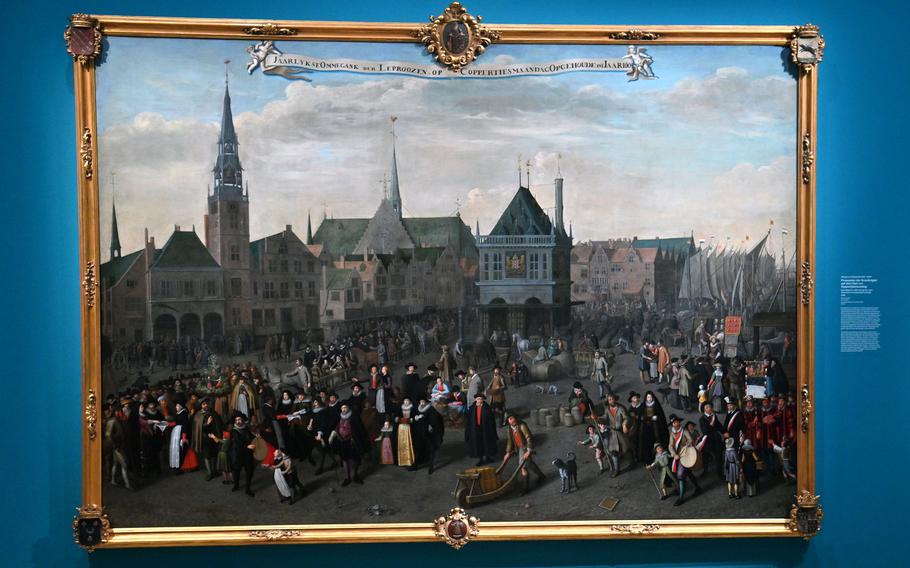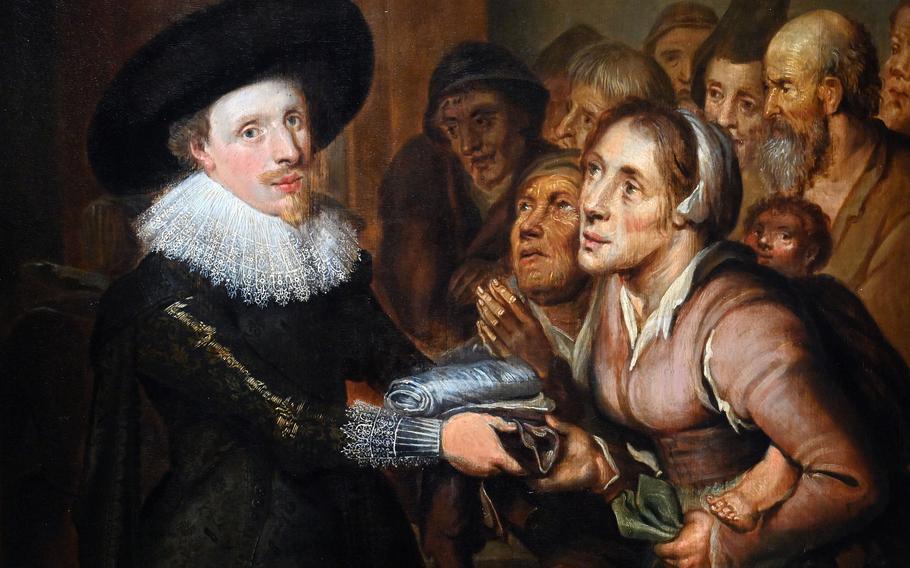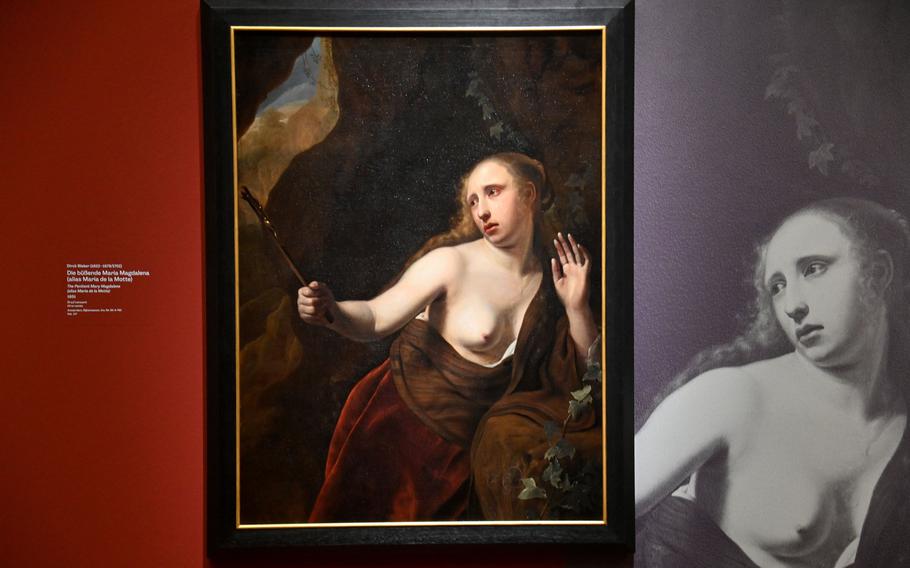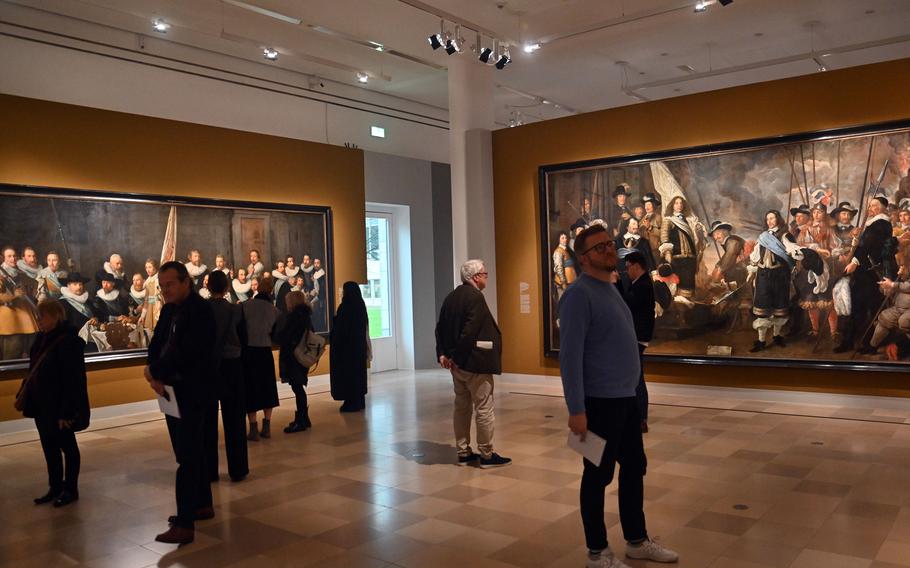
Visitors to “Rembrandt’s Amsterdam. Golden Times?” check out the works by Dutch masters. The exhibit at Frankfurt’s esteemed Städel Museum runs until March 23, 2025. In the center is Nicolas Pietersz Berchem’s “Allegory on the expansion of Amsterdam.” (Michael Abrams/Stars and Stripes)
The Dutch capital of Amsterdam grew from a sleepy fishing town to a vibrant city in the 17th century, ushering in a golden age for the Netherlands.
Trade to what was then known as the East and West Indies provided employment and unbelievable wealth. The city’s religious tolerance attracted many. The arts flourished.

Adrian van Nieulandt’s “Leper procession on Koppertjesmaandag” show lepers collecting alms on Dam square. (Michael Abrams/Stars and Stripes)
But was this the case for everyone? That question explains the punctuation in “Rembrandt’s Amsterdam. Golden times?” as a new exhibition at Frankfurt’s esteemed Städel art museum is titled.
It looks at the many layers of Amsterdam life in the world-famous artist’s day, presenting about 100 works by the master himself and other contemporaries.
The Dutch had defeated their Spanish Catholic rulers and driven them from the country, which became predominantly Protestant. Catholic monasteries across the land were turned into orphanages and almshouses for the poor.
And there are plenty of poor people depicted in the exhibition, along with the disabled, the mentally ill and prostitutes.
While these Amsterdam denizens are present in the art, however, the reason usually was that the paintings were about the people responsible for running the institutions.

A detail photo of the warden an almshouse distributing clothing to the poor. The painting by an unknown artist, but possibly David Vinkboons, is on display at the exhibit “Rembrandt’s Amsterdam. Golden Times?” at the Städel in Frankfurt. (Michael Abrams/Stars and Stripes)
The regents, superintendents and wardens commissioned artists to paint group portraits, often being depicted in their institutions so the viewer sees the downtrodden of Amsterdam in the paintings.
A good example of this in the exhibit is “The Registration of Paupers and Orphans at the Aalmoezeniershuis,” possibly by David Vinckboons.
The group portraits here are an extension — or expansion, if you will — of the ones done for Amsterdam’s shooting associations and militias. The most famous example of these is Rembrandt’s “The Night Watch,” which hangs in the Rijksmuseum in Amsterdam.
An early example on display in the Frankfurt exhibition is “Squad F of the Arquebusiers (Kloeveniers),” from 1557, about 50 years before Rembrandt’s birth.
In the head-to-shoulder portraits grouped at two rows of tables, one can see the evolution in style in the large paintings by Nicholas Eliasz Pickenoy and Govaert Flinck – contemporaries of Rembrandt’s – that depict companies of crossbowmen.

Dierk Bleker’s “The sentient Maria Magdalene (alias Maria de la Motte),” seen here at the exhibit “Rembrandt’s Amsterdam. Golden Times?” was once evidence in a divorce proceeding. The wife of merchant Bartholomew Blijdenburgh accused her husband, who commissioned the painting, of having an affair with the model, whose real name was Maria Jonas. (Michael Abrams/Stars and Stripes)
Most of the works are on loan from the Amsterdam Museum, which is undergoing a major renovation. Other pieces come from, among others, the Rijksmuseum, the Metropolitan Museum of Art in New York and the Städel’s own collection.
Rembrandt and his contemporaries were also commissioned to paint group portraits of the city’s guilds, one of which was made up of surgeons.
From that commission, two works on display in Frankfurt stood out to me.
“The Osteology Lesson of Dr. Sebastiaen Egberts” shows the skeleton of an English sailor executed for piracy, surrounded by a group of surgeons.
It’s joined by Rembrandt’s “Anatomy Lesson of Dr. Jan Deijman,” a rather gruesome scene of a cadaver dissection. Only a fragment has survived, but the artist’s working sketch of the complete painting is displayed with it.
While the exhibition is remarkably interesting, it is decidedly not cheerful. One poignant example of its somber atmosphere is the mesmerizing portrait of Barend Jansz Bode.

A visitor to “Rembrandt’s Amsterdam. Golden Times?” looks at a portrait of Barend Jansz Bode, also known as Malle Baandje. He was a resident of an Amsterdam orphanage. Usually orphans left the institutions between the ages of 20-25. Because of mental illness, Bode remained his whole life. Who painted the picture and why it was commissioned is unknown. (Michael Abrams/Stars and Stripes)
Also known as Malle Baandje, he was a resident of an Amsterdam orphanage. Usually orphans left the institutions between the ages of 20 and 25, but because of mental illness, Bode remained his whole life.
Who painted the portrait, who commissioned it and why are unknown.
By the time the visit ends, it’s clear that for all the wealth and success of this dynamic 17th century city, not all that glittered was gold.

Visitors check out some of the monumental paintings in the exhibit “Rembrandt’s Amsterdam. Golden Times?” The paintings by Nicholas Eliasz Pickenoy, left, and Govaert Flinck, depict companies of crossbowmen. The exhibit at the Städel in Frankfurt runs until March 23, 2025. (Michael Abrams/Stars and Stripes)
On the QT
Address: Schaumainkai 63, Frankfurt
Times: Exhibition runs until March 23, 2025. Open hours are 10 a.m.-6 p.m. Tuesdays, Wednesdays, Fridays, Saturdays and Sundays; and 10 a.m.-9 p.m. Thursdays. Closed Mondays.
Prices: 18 euros for adults; 16 euros for kids 12 to 17; free for kids under 12. Special offers available online.
Food: There is a cafeteria in the museum shop for drinks and sandwiches; Holbein’s restaurant offers fine food and is open until midnight.
Information: https://www.staedelmuseum.de/de/